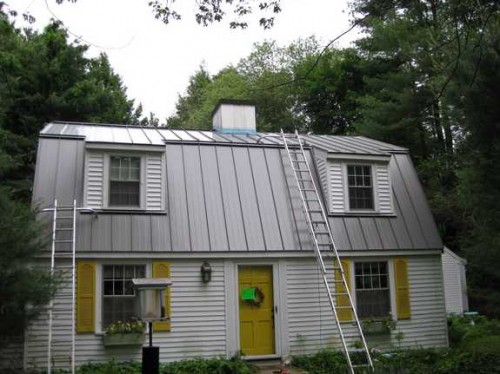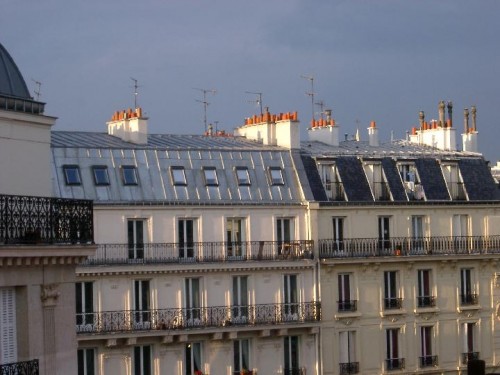I believe that most people would agree with a notion that sensibly-applied environmental responsibility, and building in a sustainable and green way, can help preserve the environment, and make it better not just for us, but also for the future generations.
In the light of this concept, I would like to present and advocate a case for residential and light commercial metal roofing, which has become one of the fastest growing roofing products in America. So what, right? Well, since green theme is one of the topics covered in this blog, let me show you how modern metal roofing is relevant and useful from the ecological, environmental, and sustainable building practices points of view.
Green Building Manifesto
Before I cover the role and significance of green metal roofing in the US, I would like to share my version of green building concept:
When you combine science and technology with environmental awareness and ecological considerations, you can start building in sustainable way that is good for the people, environment and future generations. When sustainable building ideas and concepts reach the level of commercial integration, they can become truly powerful because these ideas are no longer just on paper, but rather at work affecting, and hopefully improving the world and the environment.
In the United States, we are witnessing this positive environmental building change in the roofing industry today. In the U.S., where most roofs are covered with asphalt shingles, metal roofing has emerged as a sustainable roofing product that is gaining popularity and market share every year. According to the National Association of Home builders Research Center, 20 billion pounds of asphalt shingles are dumped into U.S. landfills every year. Metal roofing is an ecologically safe building material containing anywhere from 25 to 95% of post consumer content (depending on the product manufacturer), and it is 100% recyclable at the end of its useful life.
Worldwide Perspective
Did you know that over 50% of all rooftops in Paris are Zinc Metal Roofs?
You may find this surprising, I certainly did, but over 70 percents of residential buildings in Europe are covered with metal roofing. It is also interesting to note, that in Europe, zinc is the most commonly and widely used metal roofing material. The uncoated zinc roofing performs extremely well in the harshest climates, and can last nearly 100 years. In the U.S., Zinc and aluminum coated and Kynar painted steel is the most widely used metal roofing material. Zinc and aluminum coating coupled with high quality Kynar paint finish provides excellent protection against oxidation and corrosion. Kynar paint coating gives steel roofing solar reflective properties, which qualifies it as a cool roof.
Residential Standing Seam Metal Roof

Energy star became an active participant assigning energy star ratings to cool-roof rated metal roofing products. Cool metal roofs reflect solar radiant heat, which reduces air conditioning load and can often result in energy savings of 30% and greater in warm seasons. The United States government stimulus package provides tax credits to homeowners who invest in a qualifying energy star rated metal roofing system.
Asphalt Shingle vs. Metal
Not to bash asphalt shingle roofing industry, but the quality of asphalt shingle roofs, an oil based product, has been steadily declining over the last few decades. Today, an average expected life span of the asphalt shingle roof is only 17 years. In hotter climates such as Florida and Texas the lifespan of an asphalt shingle roof may be as short as 10 years. Metal roof installed correctly can last for many decades providing energy savings and comfort for the building occupants.
Pros and cons of metal roofing
Most of today’s commercially available metal roofing systems feature great warranties and provide significant energy savings to the building owner. However, the initial cost of installing a metal roof is the biggest hurdle for the building owners. Metal roofing materials represent quality and cost more than its asphalt counter-parts. The cost of installing metal roofing is also higher because metal roofing requires professional installation and it takes longer to install than asphalt shingles.
Aside from the higher cost of initial investment, metal roofing provides many benefits over asphalt shingle roofs. Most modern metal roofs can withstand hurricane winds with speeds of 110 miles per hour and higher. Metal roofing provides excellent hail damage and fire protection. Insurance companies in some 20 states reduce homeowners insurance by as much as 35% for the homes protected with metal roofing.
Metal roofing systems such as standing-seam are solar roofing ready. Easy to adhere solar PV panels can be easily integrated with standing-seam roofs, which can help take the energy efficiency of your home to yet another level. Solar installation for a metal roof may well pay for itself in seven to ten years.
Conclusion
It seems that the status of metal roofing is still not quite clear. Some entities consider it as a green building material, while others do not. Like with any new idea or concept, it takes time to break in and be accepted into the mainstream. Especially given the threats that metal roofing imposes to the manufacturers of conventional asphalt shingle roofing materials. Either way, metal roofing is here to stay, and it has a strong commercial banking and demand that will perpetuate its growth in popularity. Regardless of status, facts will remain the facts: metal roofing is a sustainable, long lasting, ecologically and environmentally safe building material that can save our landfills from asphalt shingle deposits and improve the longevity and quality of residential, commercial, industrial, and institutional roofs.
References:
Author Bio:
